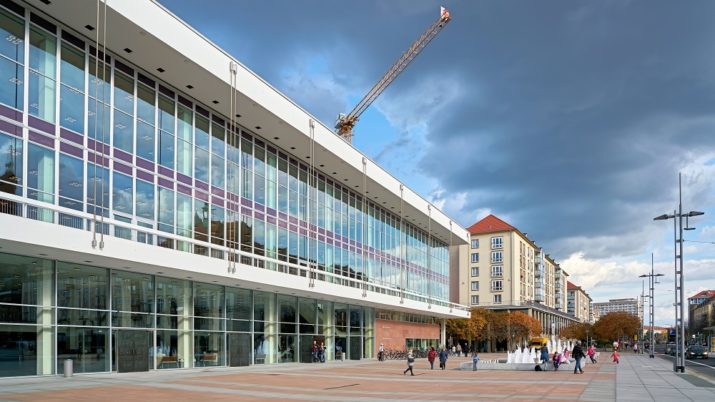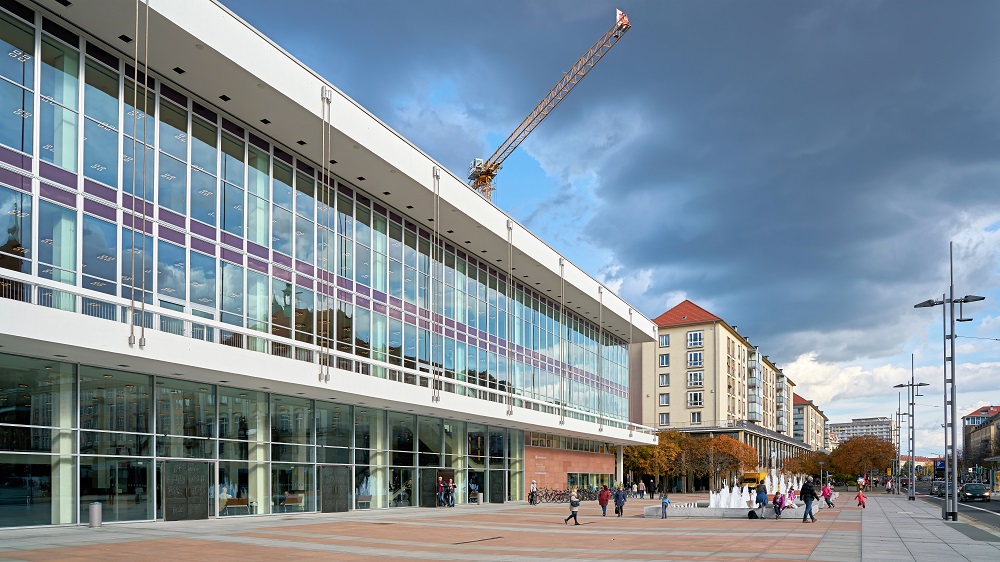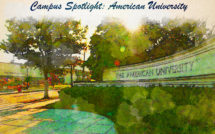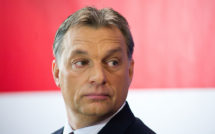
Between the “Street” and the “Salon,” the Local and the National: Mediating Intelligentsia and the German New Right in Dresden

This is part of our special feature on Radicalism and Violence.
On the night of March 8th, 2018, large crowds rushed into the Kulturpalast, the central Dresden venue for cultural events. Built under the socialist regime in the 1960s and threatened by demolition in the 2000s, the space hosted a debate between two local authors, Uwe Tellkamp and Durs Grünbein.[1] Both started as authors writing about Dresden urban society before and after reunification. Both have gained national and international fame with their work. And both publish with the renowned German Suhrkamp publishing house. However, this is about as far their commonalities reach. On this night, each represented a different camp in a process of polarization that has struck Dresden, Germany and Europe as a whole. A polarization that oscillates between universal humanism and a particular preference for “one’s own people” over “others,” as Tellkamp puts it. For many Dresden citizens, Tellkamp, still living in Dresden, represents the latter, while Grünbein left Dresden long ago and has become a European cosmopolitan. For a broader public, Tellkamp represents the New Right’s[2] assault on liberal democracy while Grünbein is seen as its defender.
The polarized “camps” represented by these two authors could be strongly felt in the audience, which was made up in large part of Dresden’s educated classes. Both authors received an equal amount of applause for their comments in a debate that was meant to be on the state of freedom of speech in Germany, but quickly turned into a debate on German’s refugee and asylum policy. The event was remarkable, as it was not two opposing politicians confronting each other, defending their actual and proposed policies. Nor did it involve subject-matter experts. Rather, the audience witnessed a heated debate between two writers or “public intellectuals,” who argued as representatives of their camps. After years of alleged or perceived decline,[3] public intellectuals, it seems, are returning to the center stage of the political debate. And with Grünbein’s and Tellkamp’s debate on this early spring night, it becomes clear that the polarization is not only between the economically left-behind and the winners of globalization,or between successful Wessis and disenfranchized Ossis, but between a nationalist and a universalist conception of humanity.
Public intellectuals, resonance and communities of assumptions
While Tellkamp and Grünbein are well-known figures in the German public sphere, and their debate received a lot of attention in the German mediascape, little attention is paid to less prominent, more local intellectuals. This is probably due to the tendency to associate the social concept of the “public intellectual” with a certain degree of grandeur or prestige, and a national or even global audience. And while it is true that such highly visible public intellectuals as Russell, Sartre, Heidegger, or Bourdieu had an immense influence not only on what Baert calls an intra-intellectual arena (an arena confined to intellectuals) but on a larger public and even globalized audience, the role of the less-visible local intellectual can be just as central, especially in a time of perceived crisis and social transformation.[4] More than any other political group, the German New Right (NR) has understood this importance of local intellectuals and their influential position in local public spheres. While most media and political observers pay attention to populist Alternative für Deutschland (AfD) politicians, the slow but effective work of local intellectuals remains under the radar.
But how to define an intellectual? Like most concepts, the concept of the “intellectual” is debated in the literature. Older theories saw intellectuals as “free floating”[5] and detached from a material world or as “organic” representatives of a certain class or political community.[6] More recent theory, such as the contributions of Patrick Baert, see intellectuals more generally as producers of “innovative intellectual goods, like plays, novels, or philosophical treatises,”opposing them to “critics” who paraphrase and comment on these goods, and thus take on the role of gatekeepers.[7] Baert proposes a “theory of positioning” that explains the success of intellectuals in a broader public arena through three core points.[8]
Intellectuals reach a broad audience beyond the intra-intellectual circle when their ideas are packaged and labelled “in terms of a coherent intellectual doctrine” and delivered “in a unified fashion.” Secondly, these intellectuals need a “logistical, ideological, institutional, and … charismatic capacity … to establish an efficient, vibrant, and resourceful relationship” with the intellectual scene, as well as the publishing industry and the critics. Lastly, and probably most importantly, their ideas need to “resonate with recent socio-political experiences of particular sectors of the population.”
This resonance is central to establishing and upholding what Amitai Etzioni called a community of assumptions,[9] a community that is not made up of the entire public sphere but of elites and “attentive publics.” These communities are based on “shared worldviews, judgments about challenges faced, and ways to deal with them.” The establishment of such communities can take years, but once they are established “the validity of these assumptions is taken for granted.” Public intellectuals play a central role here as they challenge old communities of assumptions and pave the way for new ones, as old ones are perceived not to match new realities.
Without an attentive public with whose experiences the public intellectuals’ ideas resonate, the spread of ideas is more unlikely. Here lies the populist element of public intellectuals, which often makes them an object of mockery by academic intellectuals, whose main area of intellectual activity remains in the intra-intellectual sphere. Yet, as Geiger noted in the 1940s,[10] intellectuals include not only what he calls an “original creative intelligentsia generating high culture through the creation of new cultural substance” (such as artists, writers, researchers, inventors, etc.), but equally a popularizing intelligentsia. The latter can be considered intellectuals as long as “their teachings are individually processed and present the thoughts in a new way.” Important here is less the degree of intellectual abstraction, but rather the communicating intelligence and capacity to create new cultural values in a popular form. In the case of the German NR, this means that through a “mediating intelligentsia” intellectual radicalization can drive, legitimizes, and aestheticize a radicalization of parts of the mainstream.
Local intellectuals as a mediating intelligentsia in the German NR – the case of Dresden
To understand how this happens, Etzioni’s community of assumptions, Baert’s “public intellectual arena” and Geiger’s “mediating intelligentsia” can be applied at the local level. Just like national public spheres, cities develop and maintain a local public sphere that exists in relative independence, but also interconnects with national and transnational public spheres. Let’s return to Dresden, a city known for its dominant conservatism and that has, in recent years, developed into a central intellectual hub of the German NR.
Dresden has a long tradition of an active civil society and an intellectualism that traditionally shifted between a more conservative tradition, often with close ties to the political elites of the state of Saxony, and a more non-conformist bohemia, made up of artists and writers.[11] In the years following the so-called refugee crisis in Germany, a small but influential network of “intellectual salons” has emerged, reaching from the outskirts of the city to the surrounding small towns, each representing a different middle- and upper-class milieu.
Arguably, the most prominent figure is a local bookshop owner and multiple winner of the German bookshop prize.[12] After years of successful business in a small bohemian suburb of Dresden, she has taken on the role of political activist, with close ties to the German NR’s mastermind Götz Kubitschek,[13] as well as the AfD. Together, with her husband, she has organized a large number of political and cultural events, including new and old, local and national NR authors, and giving them a platform to discuss their ideas, to network and to bring them together with a more local audience. Out of these meetings, new initiatives on the street are conceived and organized, such as the project “Art Is Free,” which consisted of placing a Trojan horse in front of the Kulturpalast and was meant to symbolize the invasion of German culture by foreign cultures. Here, former PEGIDA (Patriotic Europeans against the Islamisation of the Occident) activists came together with well-established and renowned public intellectuals, such as the psychologist Hans-Joachim Maaz[14] on the same stage. Due to her activism, the bookshop owner has become an influential figure in the NR and even in the AfD. Earlier this year, she was confirmed member of the board of the party’s newly founded Desiderius-Erasmus-Foundation.
Yet NR salons do not only flourish in cultural hubs like Dresden. Only a short train ride from Dresden, Pirna has become home of the “citizens” initiative’ Pirna Pro Patria, founded by successful local businessmen and tax accountants. Similar to the bookshop in Dresden, NR intellectuals from all over Germany, as well as local figures, present their views and books and discuss them with a more local audience. However, their activities are not restricted to the “salon.” The initiative has been attempting to exert influence on the local authorities, for example, by offering money for projects in their interest. Another example is the yearly embellishment of the fountain on the market square in Pirna for Easter. As one of the leaders of Pirna Pro Patria proudly told me, the initiative managed to end the portrayal of messages of Gutmenschen[15] (calling for diversity and tolerance) and return to what he called the “traditional way of decorating” the fountain without what he sees as “political messages.”
The members of these circles maintain close links to the AfD, as well as to a more general NR network of intellectuals meeting regularly in self-styled salons in Berlin and other cities, including former moderate conservatives, far-left activists and social democrats, such as Henryk M. Border,[16] Frank Böckelmann[17] and Thilo Sarazzin.[18] As an interface between local attentive audiences and a broader national intellectual network, they allow for abstract ideas to resonate with the local Zeitgeist, give diffuse emotions and experiences an ideological framing, and insert them into a coherent intellectual doctrine. Hence, the function of local intellectuals is twofold. On the one hand, the contact with locals brings the NR intellectuals in touch with local experiences. On the other hand, the intellectual ideas presented in the discussions provide the locals with an abstract framework for their experiences. Furthermore, the ideas promoted by the NR, and specifically the personalities behind them, provide an intellectual legitimization for far-right perceptions that are highly contested in current German society. Local intellectuals are thus central to the formation of an alternative community of assumptions or, in other words, a NR counter-culture.
However, it is not only such “independent” private initiatives that have reinforced the NR’s efforts to reach a broader audience. Even public institutions have become a platform of NR activism, albeit in a different way. In Dresden it is, ironically, the Hannah Arendt Institute for the Research of Totalitarianism that has become the host of an important intellectual contributor to the German NR. While its status as a valuable academic institution producing high-quality academic research is still valid, it cannot be denied that the institute’s fundamental aim to treat far-right and far-left totalitarianism equally has allowed one of its academic members to play the “totalitarianism card” against Angela Merkel’s so-called “welcome culture.”
Lothar Fritze, professor at the Technical University in Chemnitz and member of the Hannah Arendt Institute’s academic staff researching “totalitarian thinking in national socialist and communist ideology,” has become a frequent contributor to the NR journal Tumult, also based in Dresden. Here he writes articles with such titles as “The Limits of Universalism. On the Legitimacy of the Preference of the Particular.”[19] Fritze also presented a paper on Marx and the use of his theories for “the conservative and right camp” at one of the conferences organised by Kubitschek’s so-called Institut für Staatspolitik (Institute for State Policy or Politics).[20] In his popular book The Evil Good Will: Rescuing the World and Self-Sacrifice in the Migration Crisis,[21] he portrays the German “welcome culture” in the early weeks of the so-called refugee crisis as an ideology and expression of a utopian universalism that is close to communist totalitarianism. Both have in common that they aim to reduce human suffering but actually achieve the opposite. Equally, both utopias are being aggressively enforced on the local population and those attacked who resist its “hypermoral reflexes.”
The narrative of liberal and leftist hypermoralism and totalitarian tendencies put forward by Fritze is not new. It has long been part of the NR’s repertoire and can be traced back to Arnold Gehlen’s 1969 book Moral and Hypermoral.[22] As Jan-Werner Müller notes with regard to the NR in the 1990s, its “’anti-totalitarian’ strategy” consists of breaking the dominating “left-liberal media, which, in its zeal for ‘political correctness,’ had set up a ‘discourse-apartheid’, through which members of the Right were systematically silenced and excluded”. This framing allows to equate the Left “with the National Socialists’ ‘directing of consciousness’” and thus setting up “a homogenous, quasi-totalitarian enemy” against which the “New Right could present itself as automatically anti-totalitarian.”[23]
The bookshop owner, the organizers of the salon in Pirna, and local academics, thus play a central role in spreading and legitimizing NR ideas. As popularizers of NR thought, they are a sort of interface between a more national network of NR intellectuals and the local community in which they are strongly embedded. Eloquent, well-read, and often economically successful, their views and actions are highly respected. And, following the PEGIDA protests and a growing unease of many with Merkel’s asylum and refugee policy, their siding with the central claims of PEGIDA and AfD, widely seen as populist actors, serves as a means to show one’s colors—to create a local intellectual community of assumptions alternative to the one perceived as the “mainstream media.”
From a political standpoint, many observers may be tempted to deny the status of intellectualism to NR thinkers and denounce them as populist propagandists or mere ideologues. However, this won’t curb the appeal they have for many of their attentive publics. Rather, what is of importance here is not so much how liberals or leftists perceive new and far-right thinkers, but how they are perceived by their respective and growing audiences and why.
The support of local intellectuals – a strength of the German NR
Looking back at the rise and subsequent failure of the German NR, Müller argued eighteen years ago that the central reason for this failure was a lack of institutional support and ideological innovation. Rather than looking at NR intellectuals, those “genuinely worried about the resurgence of right-wing sentiments in Germany should probably look towards East German youth culture.” While ideological innovation certainly remains a problem for the NR, institutional support for the spread of its ideas, as well as their resonance with an attentive community of assumptions, has increased dramatically in comparison to the 1990s. With the AfD as a sort of parliamentary representation and the increasing support of public intellectuals at the local and national level, as well as a broad array of “citizens’ initiatives,” today’s NR is in a far better shape than the one in the 1990s.
In Dresden, the highbrow NR Müller identified primarily with West German publishers has merged with an East German intellectual sphere increasingly active at the local level and amplifying its influence through alternative online media channels. While the role of online media and the East–West German dimension in the rise of the NR are in urgent need of research, the examples above show that today it is not so much East German far-right youth that dominates the public debate but NR ideas elaborated by an intellectual caste over many years. Not the ideas propagated are new but the NR’s capacity to rely on a “mediating intelligentsia” that it lacked in the past. Through a continuously developing network of local and national intellectuals, a NR counter-culture and an alternative “community of assumptions” has been emerging, reinforced by and mirroring the echo chambers that have developed online.
The figures named above are only a few examples of a larger shift in parts of the German intellectual sphere. At the national level, more than a few well-established intellectual figures, such as Henryk M. Broder, the writer Monika Maron,[24] or the painter Neo Rauch,[25] have implicitly and explicitly shown their sympathy and support for a NR intelligentsia that, just a few years ago, appeared only at the margins of public debates. Much attention has been paid to such actors as Steve Bannon and his efforts to build up a “populist far-right movement” in Europe. Instead of following his media campaign, it would be more useful to pay attention to the effective ways less-visible local intellectuals shape and influence attentive audiences and help generate, reinforce and widen communities of assumptions at the local level.
Julian Göpffarth is a PhD candidate at the LSE’s European Institute and a fellow at the Centre for Analysis of the Radical Right. His research focuses on intellectual support of far-right populism and nationalist ideologies in Germany. As part of his research he has just finished six months of fieldwork in Dresden.
Photo: DRESDEN, GERMANY – OCTOBER 12, 2017: Kulturpalast in the city center of Dresden. The Kulturpalast is the venue, library, and home of the Dresden Philharmonic. | Shutterstock
References:
[1] Accessible online: https://www.youtube.com/watch?v=4X4ArZAcmbg&t=1s.
[2] In the German context, the term New Right describes a loose network reaching from conservative to far- and extreme-right intellectuals that emerged in the 1970s and was strongly influenced by the French Nouvelle Droite.
[3] See, for example, Richard A. Posner, Public Intellectuals: A Study of Decline (Cambridge, MA: Harvard University Press, 2001).
[4] Thomas Kroll and Tilman Reitz, ‘Zeithistorische und wissenssoziologische Zugänge zu den Intellektuellen der 1960er und 1970er Jahre’, in Thomas Kroll and Tilman Reitz (eds), Intellektuelle in der Bundesrepublik Deutschland: Verschiebungen im politischen Feld der 1960er und 1970er Jahre (Göttingen: Vandenhoeck & Ruprecht, 2013), pp. 7–18, here p. 18.
[5] Karl Mannheim, Ideology and Utopia (London: Routledge, 1991).
[6] Antonio Gramsci, Selections from the Prison Notebooks (New York, NY: International Publishers, 1971). Gramsci’s theory has regained popularity in recent years. Part of the NR’s strategy to gain ‘cultural hegemony’ since the 1970s, it is also put forward by leftist and liberal intellectuals in the public debate (see, for example, Naika Fouratan, ‘Es ist unser Land, verteidigen wir es gemeinsam’, in Tagesspiegel Online, published on 22 July 2018. Accessible online: https://www.tagesspiegel.de/politik/migrationsforscherin-naika-foroutan-ich-sehe-da-eine-emotionale-distanz/22830476-2.html.
[7] Simon Susen, ‘Reflections on Patrick Baert’s The Existentialist Moment: The Rise of Sartre as a Public Intellectual’, in Patrick Baert and Simon Susen (eds), The Sociology of Intellectuals: After ‘The Existentialist Moment’ (Cham: Palgrave Macmillan, 2017), pp. 1–122, here p. 11.
[8] Ibid., p. 15
[9] Amitai Etzioni, ‘Introduction: Are public intellectuals an endangered species?’, in Amitai Etzioni and Alyssa Bowditch (eds), Public Intellectuals. An Endangered Species? (Lanham, MD: Rowman & Littlefield, 2006), pp. 1–27, here pp. 6–7.
[10] Theodor Geiger, Aufgaben und Stellung der Intelligenz in der Gesellschaft (Stuttgart: Enke, 1949), pp. 13–17.
[11] For a history of the intellectual and bohemian tradition in the socialist GDR and Dresden specifically, see Paul Kaiser, Boheme in der DDR: Kunst und Gegenkultur im Staatssozialismus (Dresden: Institut für Kulturstudien, 2016).
[12] During my fieldwork I agreed with the protagonists I interviewed in person (the bookshop owner and the founder of Pirna Pro Patria) to keep them anonymous.
[13] Kubitschek has been named ‘The Prophet of Germany’s New Right’ by the New York Times: https://www.nytimes.com/2017/10/10/magazine/the-prophet-of-germanys-new-right.html.
[14] Hans-Joachim Maaz is a prominent and widely quoted psychoanalyst whose analysis of the East German population and their traumatic experiences under socialism as well as during and after reunification has been influential nationally and internationally. His most recent book, Das falsche Leben: Ursachen und Folgen unserer normopathischen Gesellschaft (München: Beck, 2017), in which he argues that we live in a normopathic society, i.e. a society incentivising in its members an ‘obsessive conformity’, is a popular read among NR intellectuals.
[15] The term Gutmensch (literally ‘good human’) sarcastically describes people who aim to do good and, in the eyes of the far and NR, seek approval for it without caring about the consequences of their actions. Besides such terms as links-grün versifft (left-green polluted) and linker Mainstream (leftist mainstream), it belongs to the repertoire of the far and NR’s analysis of what they see as the left-liberal-dominated establishment.
[16] Henryk M. Broder is a well-known German journalist and political observer whose origins lie in the political left. He has published in national newspapers such as Süddeutsche Zeitung, Der Spiegel and Die Welt. In recent years he has become a strong critic of Islam.
[17] Frank Böckelmann was member of the 1960s far-left Situationist International before he founded the journal Tumult. Tumult was initially a far-left publication and, since its re-foundation in 2013, has become a central organ of the intellectual German NR while Böckelmann has evolved into one of its principal intellectuals.
[18] Thilo Sarrazin is a member of the social democrat SPD and a former Deutsche Bank board member. Since 2010 he has gained prominence through a number of publications critical of multiculturalism, Islam and the EU, most notably his bestselling 2010 book Deutschland schafft sich ab (Germany abolishes itself). The German NR sees in him an important door opener for their ideas.
[19] Lothar Fritze, ‘Grenzen des Universalismus. Über die Legitimität einer Bevorzugung des Eigenen’, Tumult, Winter 2015/2016.
[20] See https://staatspolitik.de/category/c10-akademien/.
[21] Lothar Fritze, Der böse gute Wille: Weltrettung und Selbstaufgabe in der Migrationskrise (Manuscriptum: Berlin, 2016).
[22] Arnold Gehlen, Moral und Hypermoral: Eine Pluralistische Ethik (Frankfurt: Klostermann, 2016).
[23] Jan-Werner Müller, Another Country: German Intellectuals, Unification and National Identity (New Haven, NJ: Yale University Press, 2000), pp. 202–3.
[24] See, for example, Monika Maron, ‘Links bin ich schon lange nicht mehr’, published on 30 June 2017 on Neue Züricher Zeitung Online: https://www.nzz.ch/feuilleton/bundestagswahl-links-bin-ich-schon-lange-nicht-mehr-ld.1303513.
[25] See ‘Das ist die Talibanisierung unserer Lebenswirklichkeit’, interview with Neo Rauch and Rosa Loy in Handelsblatt, published on 19 April 2018: https://www.handelsblatt.com/panorama/kultur-kunstmarkt/kuenstlerpaar-rosa-loy-und-neo-rauch-das-ist-die-talibanisierung-unserer-lebenswirklichkeit/21189370.html.
Published on October 2, 2018.




